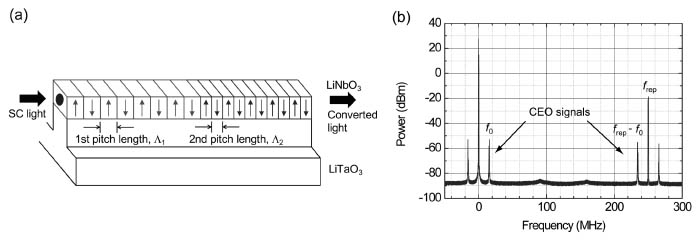Optical Science Laboratory
A carrier-envelope offset (CEO) stabilized optical frequency
comb provides dramatic progress in the field of precision spectroscopy
and femtosecond pulse shaping. We have studied a 25-GHz-mode-spacing optical
frequency comb provided by an externally phase-modulated laser diode, in
which each frequency mode can be separated. This is an advantage compared
to a common mode-locked laser whose repetition rate is smaller than a few
hundred megahertz. For stabilizing a frequency comb, it is common to utilize
af-to-2f self-referencing interferometer (SRI), in which one-octave bandwidth of
the supercontinuum (SC) spectrum is required [1]. However, it is difficult
to use this method for a phase-modulated frequency comb, because phase
noise in the SC spectrum increases as the frequency departs from the original
frequency. For this reason, we focus on a 2f-to-3f SRI, in which 2/3-octave bandwidth of the SC spectrum is used. By utilizing
a fiber laser for generating a SC spectrum and a dual-pitch (DP) periodically
poled lithium niobate (PPLN) ridge waveguide for third-harmonic (TH) generation,
we succeeded in detecting the CEO frequency with a high signal-to-noise
ratio (SNR) (> 30 dB).
A DP-PPLN ridge waveguide device consists of two monolithically
integrated segments with different quasi-phase matching (QPM) pitch sizes
(Λ1, Λ2) [Fig. 1(a)]. First, the second-harmonic (SH) light of the SC component
at the frequency of f1 is generated in the first segment with the pitch size of Λ1. Then, the sum frequency of the SH light (2f1) and SC component of f1’ is generated in the second segment with Λ2 [2]. Confinement of the SC light with a ridge waveguide structure and
monolithically integrated design free from optical coupling loss enables
TH generation with high efficiency.
In the experiment, a SC light (~300 mW) was generated by injecting the output from the fiber laser into
a high nonlinear fiber, and spectrally separated with a dichroic mirror
at the wavelength of 1500 nm. The SH (TH) light is generated from the short-
(long-) wavelength component [~1200 (1800) nm] of the SC light. By detecting the heterodyne beat of the
two outputs with a photodetector, we detected CEO signals with a SNR >
30 dB, which is high enough for stabilizing the CEO frequency [Fig. 1(b)].
In the future, we will detect and stabilize the CEO frequency of our developed
externally phase-modulated laser with this technique.
[1] A. Ishizawa et al., Opt. Express 16 (2008) 4706.
[2] K. Hitachi et al., Electron. Lett. 49 (2013) 145.
 |
||
|